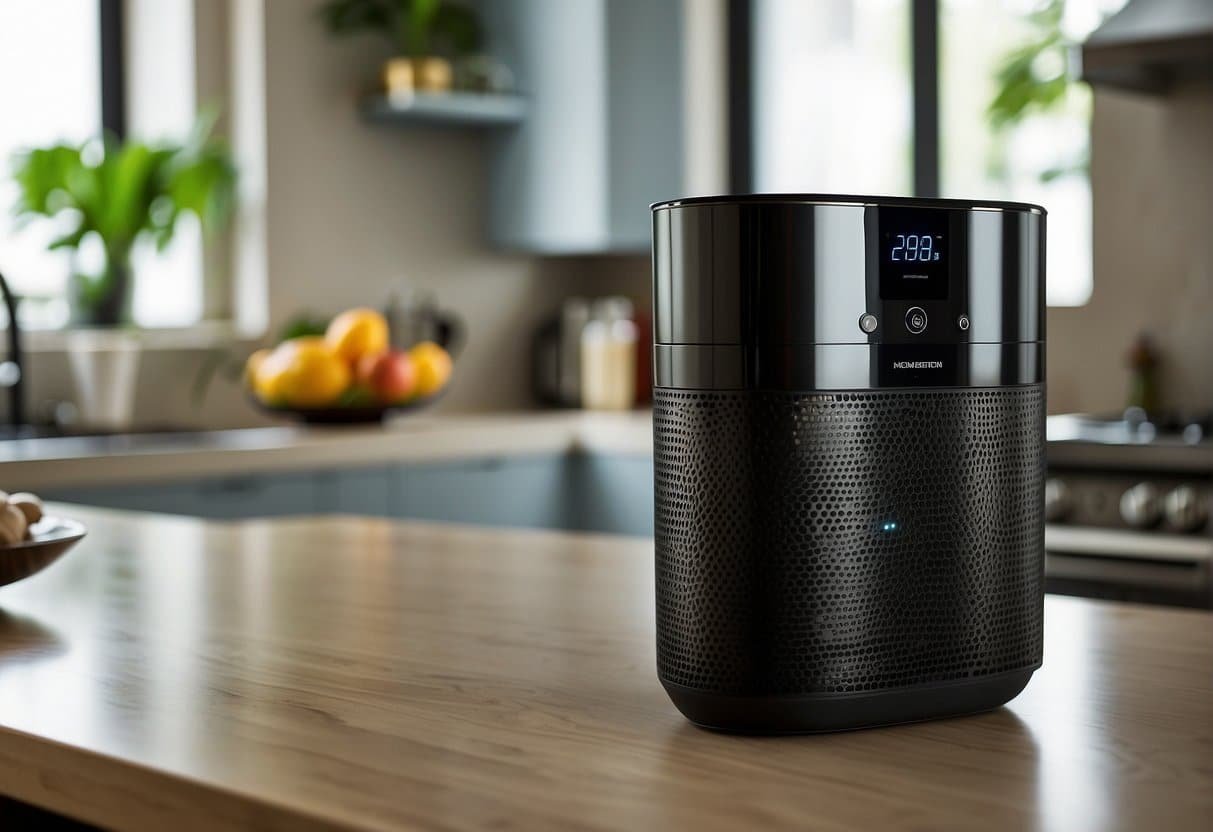Activated Carbon Air Purifiers: Efficiency in Removing Cooking Odors and Tobacco Smoke in Kitchens and Smoking Rooms
Activated carbon air purifiers have become increasingly popular in recent years, particularly in kitchens and smoking rooms. These purifiers are designed to remove cooking odors and tobacco smoke from the air, making the environment more pleasant and healthier to breathe. While the use of activated carbon filters is not a new concept, the technology has improved significantly in recent years, leading to more efficient and effective air purification.

Activated carbon filters work by trapping impurities in the air, including volatile organic compounds (VOCs), which are often responsible for unpleasant odors. The activated carbon in the filter is treated with oxygen, which opens up millions of tiny pores between the carbon atoms. These pores act like a sponge, attracting and trapping impurities in the air as it passes through the filter. As a result, the air is purified, and unpleasant odors are removed.
When it comes to air purifiers, the design and features of the device are essential to its efficacy in air purification. Performance metrics and ratings, maintenance and upkeep, health and environmental impact, and brand and model comparisons are all factors to consider when choosing an air purifier. Understanding the use of activated carbon filters in air purifiers is critical in determining which device is best for your needs.
Understanding Activated Carbon Filters
Composition and Function
Activated carbon filters are a type of air filter that use a bed of activated carbon to remove pollutants from the air. The activated carbon is made up of small bits of carbon that have been processed to be extremely porous, which increases their surface area and makes them effective at adsorbing pollutants.
When air passes through the activated carbon filter, pollutants such as volatile organic compounds (VOCs) and smoke particles are trapped in the carbon pores through a process called adsorption. This process involves the pollutants adhering to the surface of the carbon, where they are held until the filter is replaced.
Activated carbon filters are often used in air purifiers to remove cooking odors and tobacco smoke from the air. They are effective at capturing gas molecules on a bed of charcoal, making them an ideal choice for removing unwanted smells and fumes from the air.
Comparison with Other Filter Types
Activated carbon filters are often compared to other filter types, such as HEPA filters and pre-filters. While HEPA filters are effective at capturing particles such as dust, pollen, allergens, dander, and fur, they are not as effective at removing gases and odors from the air. Pre-filters are designed to capture larger particles before they reach the main filter, but they do not remove gases and odors.
Activated carbon filters are unique in their ability to remove both particles and gases from the air, making them a versatile choice for air purification. They are often used in combination with other filter types, such as HEPA filters, to provide comprehensive air purification.
Efficacy in Air Purification
Activated carbon air purifiers have become increasingly popular in kitchens and smoking rooms due to their effectiveness in removing cooking odors and tobacco smoke. These air purifiers work by trapping impurities and contaminants in the activated carbon filter, leaving clean air to circulate back into the room.
Removal of Cooking Odors
Cooking smells can linger in the air for hours, making it difficult to get rid of them. Activated carbon air purifiers can help remove these odors by filtering out the particles that cause them. These purifiers are particularly effective at removing odors from frying, sautéing, and baking.
Reduction of Tobacco Smoke
Cigarette smoke contains harmful particles, such as tar and carbon monoxide, that can cause respiratory problems. Activated carbon air purifiers can help reduce the amount of smoke particles in the air, improving indoor air quality. These purifiers can also help remove the smell of cigarette smoke from the room.
Filtering Out Airborne Particles
Activated carbon air purifiers can also filter out airborne particles, such as dust mites and mold spores, which can trigger allergies and asthma. These purifiers are particularly effective at removing particulate matter, which can cause respiratory problems.
In conclusion, activated carbon air purifiers are an effective way to improve indoor air quality in kitchens and smoking rooms. They can remove cooking odors, reduce tobacco smoke, and filter out airborne particles, leaving clean air to circulate back into the room.
Design and Features of Air Purifiers

Air purifiers come in different designs and sizes, but the most common type of air purifier is the activated carbon air purifier. These purifiers are sleek and aesthetically pleasing, making them a popular choice for homeowners. They are energy-efficient and can run for long hours without consuming too much energy.
Noise Level and Airflow Considerations
When choosing an air purifier, it is important to consider the noise level and airflow. Some air purifiers have multiple fan speeds, which allow users to adjust the airflow to their desired level. However, some air purifiers can be noisy, especially when running at high speed. It is important to choose an air purifier that operates quietly, especially if it is intended for use in a bedroom or living room.
Smart Technology Integration
Smart technology integration is becoming increasingly common in air purifiers. Some air purifiers can be controlled using a phone app, which allows users to monitor air quality and adjust the settings remotely. This feature is particularly useful for those who want to monitor air quality in real-time and adjust the settings accordingly. However, it is important to choose an air purifier that is easy to control and has a user-friendly interface.
Performance Metrics and Ratings

CADR and Efficiency Ratings
When looking for the best air purifier for the kitchen or smoking room, CADR and efficiency ratings are two important factors to consider. CADR, or Clean Air Delivery Rate, measures how fast an air purifier can clean the air in a room. The higher the CADR rating, the faster the air purifier can remove pollutants from the air. Efficiency ratings, on the other hand, measure how effectively an air purifier can remove pollutants from the air.
Some of the most popular and best air purifiers have been tested for their CADR and efficiency ratings. These tests provide consumers with valuable information on the value and effectiveness of these products. When looking for a fast and powerful air purifier for a larger room, it is recommended to look for a model with a high CADR rating.
Room Size and Coverage
Another important factor to consider when choosing an air purifier is the size of the room it will be used in. Air purifiers are designed to cover a certain square footage, and it is important to choose a model that is appropriate for the size of the room.
When looking for an air purifier for a kitchen or smoking room, it is important to consider the area coverage of the model. A powerful air purifier with a high CADR rating may be necessary for a larger room, while a smaller room may only require a lower CADR rating.
In conclusion, when choosing an air purifier for a kitchen or smoking room, it is important to consider both CADR and efficiency ratings, as well as the size of the room it will be used in. By taking these factors into account, consumers can choose a model that is both effective and efficient in removing cooking odors and tobacco smoke from the air.
Maintenance and Upkeep

Cleaning and Filter Replacement
Activated carbon air purifiers require regular cleaning and filter replacement to maintain their efficiency in removing cooking odors and tobacco smoke. The pre-filter, which captures larger particles like dust and pet hair, should be cleaned every two weeks. The activated carbon filter should be replaced every three to six months, depending on usage and the level of pollutants in the air.
When cleaning the pre-filter, simply remove it from the purifier and rinse it with water. Allow it to dry completely before reinserting it into the purifier. For the activated carbon filter, replacement filters can be purchased from the manufacturer or from third-party suppliers. It is important to follow the manufacturer’s instructions when replacing the filter to ensure proper installation.
Lifespan of Activated Carbon Filters
The lifespan of activated carbon filters varies depending on usage and the level of pollutants in the air. On average, activated carbon filters need to be replaced every three to six months. However, some manufacturers claim that their filters can last up to a year with proper maintenance and upkeep.
It is important to note that the lifespan of activated carbon filters can be affected by factors such as humidity, temperature, and the level of pollutants in the air. In areas with high levels of pollution or in homes with heavy smokers or frequent cooking, the lifespan of the filter may be shorter.
Activated carbon filters are generally more cost-effective than other types of air purifier filters, such as HEPA filters. However, the cost of replacement filters can vary widely depending on the manufacturer and the size of the filter. Some manufacturers offer washable pre-filters, which can help extend the lifespan of the activated carbon filter and reduce the overall cost of maintenance.
In summary, regular cleaning and filter replacement are essential for maintaining the efficiency of activated carbon air purifiers in removing cooking odors and tobacco smoke. The lifespan of activated carbon filters varies depending on usage and the level of pollutants in the air, but on average, they need to be replaced every three to six months. Washable pre-filters can help extend the lifespan of the filter and reduce the overall cost of maintenance.
Health and Environmental Impact

Improving Indoor Air Quality for Health
Air pollution is one of the major concerns affecting human health. Indoor air quality is equally important as people spend most of their time indoors. Poor indoor air quality can cause respiratory problems, allergies, and asthma. Harmful substances such as volatile organic compounds (VOCs), toxins, and other pollutants can be present in indoor air.
Activated carbon air purifiers have been found to be effective in removing cooking odors and tobacco smoke. These air purifiers use activated carbon filters to adsorb the pollutants. Activated carbon is a highly porous material that has a large surface area and can effectively adsorb odors and chemicals.
Air purifiers with activated carbon filters can remove up to 99% of airborne particles, including allergens and pollutants. This makes them an effective tool in improving indoor air quality for health. The Environmental Protection Agency (EPA) recommends the use of air purifiers as a part of a comprehensive indoor air quality strategy.
Contribution to Environmental Protection
In addition to improving indoor air quality for health, activated carbon air purifiers also contribute to environmental protection. Cooking odors and tobacco smoke are significant sources of indoor air pollution. Using air purifiers can reduce the amount of pollutants released into the environment.
Activated carbon is a sustainable material that can be recycled and reused. This makes activated carbon air purifiers an eco-friendly option for improving indoor air quality.
In conclusion, using activated carbon air purifiers in the kitchen and smoking rooms can improve indoor air quality for health and contribute to environmental protection.
Brand and Model Comparisons
When it comes to activated carbon air purifiers for the kitchen and smoking rooms, there are a variety of brands and models to choose from. In this section, we will compare some of the most popular and best air purifiers available on the market.
High-End vs Budget-Friendly Models
The price of an activated carbon air purifier can vary greatly depending on the brand and model. Some of the pricier models, such as the Coway Airmega and Rabbit Air, offer advanced features like smart sensors and Wi-Fi connectivity. However, there are also budget-friendly options available that still provide excellent value.
One such model is the Levoit Core 300, which is a budget-friendly option that still offers high-quality air purification. It features a three-stage filtration system and has a compact design that can fit into any space.
Popular Models and Their Features
When it comes to popular models, the Levoit air purifier is a top choice for many consumers. The Levoit Core 300, in particular, is a popular model that offers excellent value for its price. It features a true HEPA filter that can capture particles as small as 0.3 microns, making it effective at removing cooking odors and tobacco smoke.
Another popular model is the Dyson air purifier, which is known for its sleek design and advanced features. It features a HEPA filter and activated carbon filter that can capture particles and odors. It also has a unique oscillation feature that helps circulate clean air throughout the room.
Overall, there are many great options available when it comes to activated carbon air purifiers for the kitchen and smoking rooms. Whether you are looking for a high-end model with advanced features or a budget-friendly option that still provides excellent value, there is sure to be a brand and model that meets your needs.
Frequently Asked Questions
How effective are activated carbon air purifiers in eliminating tobacco smoke particles?
Activated carbon air purifiers are highly effective in eliminating tobacco smoke particles. The activated carbon filter in the air purifier absorbs the smoke particles and other harmful chemicals present in the tobacco smoke. This helps to improve the indoor air quality and reduce the risk of respiratory problems caused by secondhand smoke.
Can activated carbon filters in air purifiers remove the smell of cigarette smoke?
Yes, activated carbon filters in air purifiers are capable of removing the smell of cigarette smoke. The activated carbon filter absorbs the smoke particles and other volatile organic compounds (VOCs) that cause the smell of cigarette smoke. This helps to improve the indoor air quality and make the living environment more pleasant.
What is the efficiency of activated carbon air purifiers in neutralizing cooking odors?
Activated carbon air purifiers are highly efficient in neutralizing cooking odors. The activated carbon filter in the air purifier absorbs the odor-causing particles and other volatile organic compounds (VOCs) that are released during cooking. This helps to improve the indoor air quality and make the living environment more pleasant.
Are activated carbon filters capable of removing volatile organic compounds (VOCs) from indoor air?
Yes, activated carbon filters in air purifiers are capable of removing volatile organic compounds (VOCs) from indoor air. The activated carbon filter absorbs the VOCs and other harmful chemicals that are present in the indoor air. This helps to improve the indoor air quality and reduce the risk of respiratory problems caused by exposure to VOCs.
How does an activated carbon filter work in air purification systems?
An activated carbon filter works by adsorbing harmful particles and chemicals from the air. The activated carbon has a large surface area that attracts and traps the particles and chemicals as they pass through the filter. This helps to improve the indoor air quality and make the living environment more pleasant.
What contaminants can be absorbed by activated carbon filters in air purifiers?
Activated carbon filters in air purifiers are capable of absorbing a wide range of contaminants, including tobacco smoke particles, cooking odors, volatile organic compounds (VOCs), and other harmful chemicals present in the indoor air. This makes them highly effective in improving the indoor air quality and reducing the risk of respiratory problems caused by exposure to indoor air pollution.






